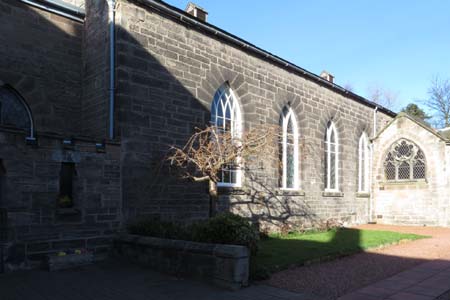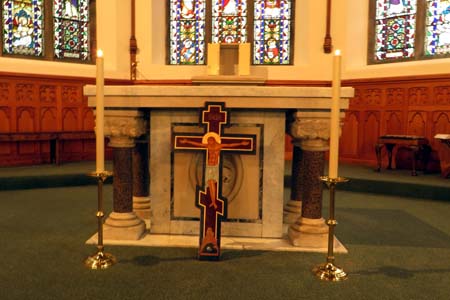| |
 |
 |
 |
| Comment on this report, or find other reports. |
 |
| Our Mystery Worshippers are volunteers who warm church pews for us around the world. If you'd like to become a Mystery Worshipper, start here. |
 |
| Find out how to reproduce this report in your church magazine or website. |
|
|
| 2841: Our Lady and St Cuthbert's, Berwick-upon-Tweed, England. |
 |
 |
 |
Mystery Worshipper: Church Mouse.
The church: Our Lady and St Cuthbert's, Berwick-upon-Tweed, England.
Denomination: Roman Catholic, Diocese of Hexham & Newcastle.
The building: It dates from 1829, with the apsidal chancel added in 1880 and a side chapel in 1925. Architecturally it is rather modest – a simple rectangular design sandwiched in between other buildings, with a small porch to the south. The interior features wooden tracery and a diamond panelled wooden ceiling. The east window is of traditional stained glass. There are large paintings of the stations of the cross around the walls.
The church: The church has been established for nearly 200 years and originally supported the Irish community of Berwick. The parish hall is some distance away but holds a number of regular services. Unfortunately the Parish Groups page of their website is blank, and the Events page advises one to consult the parish bulletin, to which no link is supplied.
The neighbourhood: Berwick-upon-Tweed is on the border between Scotland and England and is England's northernmost town. Throughout its history it has been fought over and has changed sides between Scotland and England many times. When in 1853 Queen Victoria signed the declaration that marked England's entry into the Crimean War, she is said to have signed it "Victoria, Queen of Great Britain, Ireland, Berwick-upon-Tweed and all British Dominions," thus settling the question of which side Berwick belonged to at the time. However, the Treaty of Paris, which marked the war's end, made no mention of Berwyck, and so some claimed that the town was officially still at war with Russia. In 1966, the Mayor of Berwyck was reported to have made a mutual declaration of peace with the London correspondent to Pravda. Our Lady and St Cuthbert's is found tucked within the Elizabethan fortifications.
The cast: The Revd David Phillips, parish priest.
The date & time: Good Friday, 3 April 2015, 3.00pm.
What was the name of the service?
Passion of the Lord.
How full was the building?
Mostly full.
Did anyone welcome you personally?
Someone came round and asked if we had the hymn book.
Was your pew comfortable?
It was a pew – reasonably comfortable with convenient kneelers.
How would you describe the pre-service
atmosphere?
Quiet and reverential with gentle preparations.
What were the exact opening words of the
service?
"Good afternoon."
Then notices of how the service was to proceed, including veneration of the cross.
What books did the congregation use during the
service?
Hymns Old and New (1983 version)
The good Catholics around me had their own missals with them.
What musical instruments were played?
Organ.
Did anything distract you?
I've used Hymns Old and New before, and there are many hymns I like that would have been relevant for Good Friday. However, we didn't use any of them.
Was the worship stiff-upper-lip, happy clappy, or
what?
It was the standard Good Friday liturgy, very formal, with adoration of the cross using a painted crucifix and communion from the reserved Sacrament. There was a semi-dramatised reading of the passion using three voices. The acolytes did a brilliant job – a lady next to me told me it was their first Holy Week service. But my companion, who was following the service in his missal, said that liberties were taken here and there. And the hymns we did sing struck me as rather inappropriate for the Good Friday liturgy. Finally, I thought the reserved Sacrament was brought in from the altar of repose rather matter-of-factly, as if Cook were fetching leftovers from the fridge, rather than with the solemnity and dignity befitting the continued presence of Jesus among us even on the day when he left us to be with the Father.

Exactly how long was the sermon?
10 minutes.
On a scale of 1-10, how good was the preacher?
5 – The priest had a very gentle delivery in soft lilting tones. His voice was sleep inducing and I'd slept in a strange bed the night before. I've also heard this sermon or something similar before. So please forgive me, but I am not sure how much I actually heard and how much I dozed off for.
In a nutshell, what was the sermon
about?
The nature and meaning of the Crucifixion.
Which part of the service was like being in
heaven?
The amazing acolytes doing a fantastic job.
And which part was like being in... er... the other place?
The Bible readings – it was a very odd translation. My companion, following along in the missal, said it was different from what he had in front of him but he didn't recognise what it was.
What happened when you hung around after the service looking lost?
Good Friday service is not a service to hang around after and chat.
How would you describe the after-service
coffee?
N/A.
How would you feel about making this church your regular (where 10 = ecstatic, 0 = terminal)?
3 – Even my RC leaning companion did not want to return for the Easter Vigil or Easter Day services. Neither of us is a fan of liberties being taken with liturgy.
Did the service make you feel glad to be a
Christian?
Yes. The acolytes and wide range of ages made this feel a community church.
What one thing will you remember about all this in seven days' time?
The seriousness of the acolytes genuflecting as they ran to fetch and carry. |
|
|
 |
 |
 |
| We rely on voluntary donations to stay online. If you're a regular visitor to Ship of Fools, please consider supporting us. |
 |
 |
 |
| The Mystery Pilgrim |
 |
| One of our most seasoned reporters makes the Camino pilgrimage to Santiago de Compostela in Spain. Read here. |
 |
 |
 |
| London churches |
 |
| Read reports from 70 London churches, visited by a small army of Mystery Worshippers on one single Sunday. Read here. |
| |
|
|
|
|


